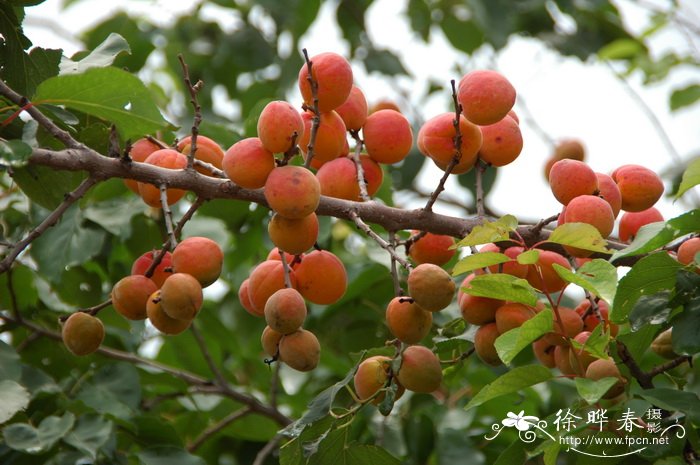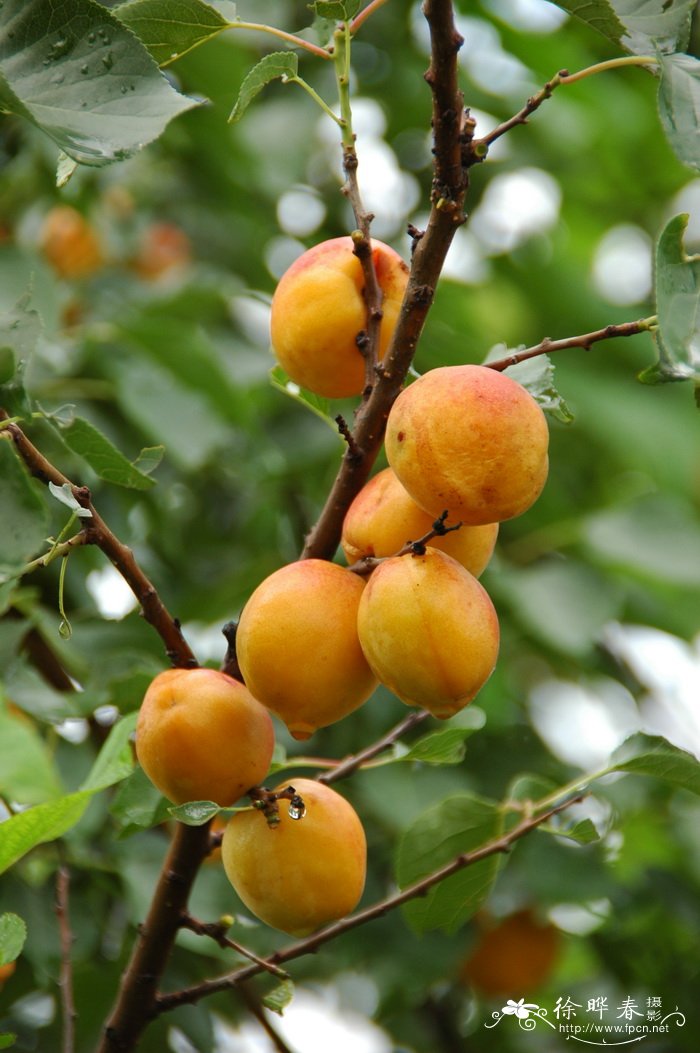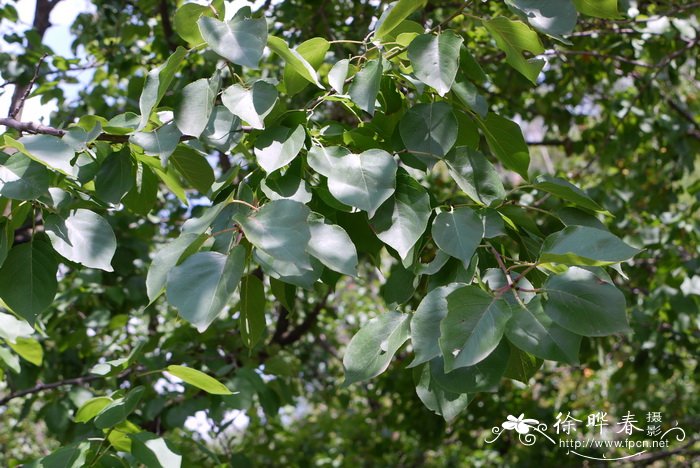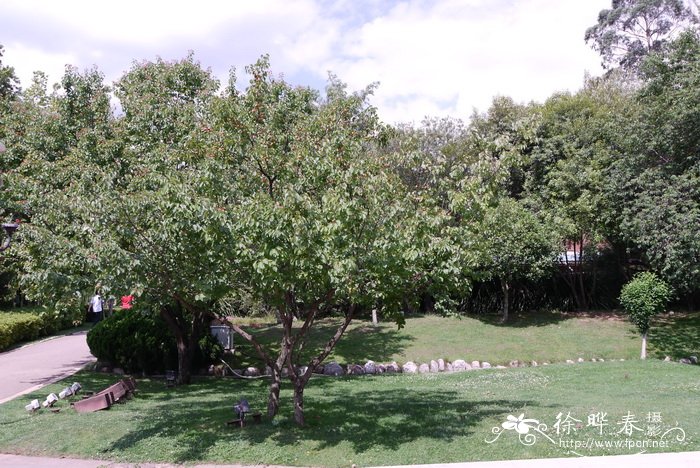杏 Prunus armeniaca
中文名(Chinese Name):杏
学名(Scientific Name):Prunus armeniaca L.
英文名(English Common Name):apricot
别名(Chinese Common Name):杏花
异名(Synonym):
科属(Family & Genus):蔷薇科(Rosaceae)杏属
形态特征(Description):Prunus tiliifolia Salisb. Prunus armeniaca L. Prunus armeniaca var. typica Maxim.
乔木,高5-8(12)米;树冠圆形、扁圆形或长圆形;树皮灰褐色,纵裂;多年生枝浅褐色,皮孔大而横生,一年生枝浅红褐色,有光泽,无毛,具多数小皮孔。叶片宽卵形或圆卵形,长5-9厘米,宽4-8厘米,先端急尖至短渐尖,基部圆形至近心形,叶边有圆钝锯齿,两面无毛或下面脉腋间具柔毛;叶柄长2-3.5厘米,无毛,基部常具1-6腺体。花单生,直径2-3厘米,先于叶开放;花梗短,长1-3毫米,被短柔毛;花萼紫绿色;萼筒圆筒形,外面基部被短柔毛;萼片卵形至卵状长圆形,先端急尖或圆钝,花后反折;花瓣圆形至倒卵形,白色或带红色,具短爪;雄蕊约20-45,稍短于花瓣;子房被短柔毛,花柱稍长或几与雄蕊等长,下部具柔毛。果实球形,稀倒卵形,直径约2.5厘米以上,白色、黄色至黄红色,常具红晕,微被短柔毛;果肉多汁,成熟时不开裂;核卵形或椭圆形,两侧扁平,顶端圆钝,基部对称,稀不对称,表面稍粗糙或平滑,腹稜较圆,常稍钝,背稜较直,腹面具龙骨状稜;种仁味苦或甜。花期3-4月,果期6-7月。2n=16。
分布(Distribution):产全国各地,多数为栽培,在新疆伊犁一带野生成纯林或与新疆野苹果林混生。世界各地也均有栽培。
用途(Use):种仁(杏仁)入药,有止咳祛痰、定喘润肠之效。
引自中国植物志英文版:FOC Vol. 9 Page 396
Armeniaca vulgaris Lamarck, Encycl. 1: 2. 1783.
杏 xing| Rosaceae | Armeniaca
Trees 5–8(–12) m tall, crown spherical, spherical-flattened, or elongated oblong. Bark grayish brown, longitudinally splitting. Older branchlets brownish, glabrous, transversely lenticellate; young branchlets reddish brown, with many pale lenticels. Winter buds purplish red, ovoid, 2–4 mm, glabrous or puberulous at scale margins, apex obtuse. Petiole 2–3.5 cm, glabrous or white pubescent, basally usually with 1–6 nectaries; leaf blade broadly ovate to orbicular-ovate, 5–9 × 4–8 cm, both surfaces glabrous, abaxially pubescent in vein axils, or adaxially white pubescent, base cuneate, broadly cuneate, rounded, or subcordate and with several nectaries, margin crenate, apex acute to shortly acuminate. Flowers solitary or occasionally paired, opening before leaves, 2–4.5 cm in diam. Pedicel 1–3 mm, pubescent. Hypanthium purplish green, shortly cylindrical, 5–7 × 3–4 mm, outside pubescent near base. Sepals purplish green, ovate to ovate-oblong, 3–5 mm, reflexed after anthesis, apex acute to rarely obtuse. Petals white, pink, or tinged with red, orbicular to obovate, 0.8–1.2 cm and ± as broad, margin shortly unguiculate, apex rounded. Stamens 20–100, slightly shorter than petals; filaments white; anthers yellow. Ovary pubescent. Style slightly longer to nearly as long as stamens, basally pubescent. Drupe white, yellow, orange, often tinged red, globose, ovoid, or rarely obovoid, 1.5 to more than 2.5 cm in diam., usually pubescent, glaucous or not; mesocarp succulent, not splitting when ripe; endocarp globose, ovoid, or ellipsoid, compressed laterally, often obtuse at ventral suture and more straight at dorsal suture, with keel-like ribs on ventral side, surface scabrous or smooth, base symmetric or rarely asymmetric, apex obtuse to ± rounded. Seed bitter or sweet. Fl. Mar–Apr, fr. Jun–Jul.
Sparse forests on mountain slopes, slopes, gullies, also cultivated; 700--3000 m. Gansu, Hebei, Henan, Jiangsu, Liaoning, Nei Mongol, Ningxia, Qinghai, Shaanxi, Shandong, Shanxi, Sichuan, Xinjiang [Japan, Korea; C Asia].
Apricots are cultivated for their edible fruit throughout China and in most temperate parts of the world. The seeds are also edible and used medicinally. Because of its long history of cultivation in China, it is difficult to know for certain whether specific collections are really wild or escaped from cultivation, but probably the species originated in C Asia.




(责任编辑:徐晔春)
学名(Scientific Name):Prunus armeniaca L.
英文名(English Common Name):apricot
别名(Chinese Common Name):杏花
异名(Synonym):
科属(Family & Genus):蔷薇科(Rosaceae)杏属
形态特征(Description):Prunus tiliifolia Salisb. Prunus armeniaca L. Prunus armeniaca var. typica Maxim.
乔木,高5-8(12)米;树冠圆形、扁圆形或长圆形;树皮灰褐色,纵裂;多年生枝浅褐色,皮孔大而横生,一年生枝浅红褐色,有光泽,无毛,具多数小皮孔。叶片宽卵形或圆卵形,长5-9厘米,宽4-8厘米,先端急尖至短渐尖,基部圆形至近心形,叶边有圆钝锯齿,两面无毛或下面脉腋间具柔毛;叶柄长2-3.5厘米,无毛,基部常具1-6腺体。花单生,直径2-3厘米,先于叶开放;花梗短,长1-3毫米,被短柔毛;花萼紫绿色;萼筒圆筒形,外面基部被短柔毛;萼片卵形至卵状长圆形,先端急尖或圆钝,花后反折;花瓣圆形至倒卵形,白色或带红色,具短爪;雄蕊约20-45,稍短于花瓣;子房被短柔毛,花柱稍长或几与雄蕊等长,下部具柔毛。果实球形,稀倒卵形,直径约2.5厘米以上,白色、黄色至黄红色,常具红晕,微被短柔毛;果肉多汁,成熟时不开裂;核卵形或椭圆形,两侧扁平,顶端圆钝,基部对称,稀不对称,表面稍粗糙或平滑,腹稜较圆,常稍钝,背稜较直,腹面具龙骨状稜;种仁味苦或甜。花期3-4月,果期6-7月。2n=16。
分布(Distribution):产全国各地,多数为栽培,在新疆伊犁一带野生成纯林或与新疆野苹果林混生。世界各地也均有栽培。
用途(Use):种仁(杏仁)入药,有止咳祛痰、定喘润肠之效。
引自中国植物志英文版:FOC Vol. 9 Page 396
Armeniaca vulgaris Lamarck, Encycl. 1: 2. 1783.
杏 xing| Rosaceae | Armeniaca
Trees 5–8(–12) m tall, crown spherical, spherical-flattened, or elongated oblong. Bark grayish brown, longitudinally splitting. Older branchlets brownish, glabrous, transversely lenticellate; young branchlets reddish brown, with many pale lenticels. Winter buds purplish red, ovoid, 2–4 mm, glabrous or puberulous at scale margins, apex obtuse. Petiole 2–3.5 cm, glabrous or white pubescent, basally usually with 1–6 nectaries; leaf blade broadly ovate to orbicular-ovate, 5–9 × 4–8 cm, both surfaces glabrous, abaxially pubescent in vein axils, or adaxially white pubescent, base cuneate, broadly cuneate, rounded, or subcordate and with several nectaries, margin crenate, apex acute to shortly acuminate. Flowers solitary or occasionally paired, opening before leaves, 2–4.5 cm in diam. Pedicel 1–3 mm, pubescent. Hypanthium purplish green, shortly cylindrical, 5–7 × 3–4 mm, outside pubescent near base. Sepals purplish green, ovate to ovate-oblong, 3–5 mm, reflexed after anthesis, apex acute to rarely obtuse. Petals white, pink, or tinged with red, orbicular to obovate, 0.8–1.2 cm and ± as broad, margin shortly unguiculate, apex rounded. Stamens 20–100, slightly shorter than petals; filaments white; anthers yellow. Ovary pubescent. Style slightly longer to nearly as long as stamens, basally pubescent. Drupe white, yellow, orange, often tinged red, globose, ovoid, or rarely obovoid, 1.5 to more than 2.5 cm in diam., usually pubescent, glaucous or not; mesocarp succulent, not splitting when ripe; endocarp globose, ovoid, or ellipsoid, compressed laterally, often obtuse at ventral suture and more straight at dorsal suture, with keel-like ribs on ventral side, surface scabrous or smooth, base symmetric or rarely asymmetric, apex obtuse to ± rounded. Seed bitter or sweet. Fl. Mar–Apr, fr. Jun–Jul.
Sparse forests on mountain slopes, slopes, gullies, also cultivated; 700--3000 m. Gansu, Hebei, Henan, Jiangsu, Liaoning, Nei Mongol, Ningxia, Qinghai, Shaanxi, Shandong, Shanxi, Sichuan, Xinjiang [Japan, Korea; C Asia].
Apricots are cultivated for their edible fruit throughout China and in most temperate parts of the world. The seeds are also edible and used medicinally. Because of its long history of cultivation in China, it is difficult to know for certain whether specific collections are really wild or escaped from cultivation, but probably the species originated in C Asia.
(责任编辑:徐晔春)
踩一下[2]
上一篇:苹果 Malus pumila
下一篇:李Prunus salicina

顶一下[4]